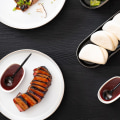Haute cuisine or fine cuisine is the cuisine of high-end establishments, gourmet restaurants and luxury hotels.
haute cuisine
is characterized by the. Early History · Classic Kitchen · New Kitchen. Haute cuisine is a French term that literally translates to “haute cuisine”.When you imagine dining at high-end restaurants today, you're most likely thinking about some of the key elements of haute cuisine. Haute cuisine focuses on the quality of the ingredients rather than the quantity of the food. Often served in moderate portions, the culinary movement was considered a bourgeoisie for society, since most French chefs worked for wealthy and noble customers. There was a time when this type of French cuisine represented the pinnacle of refinement and was once synonymous with haute cuisine.
And most haute cuisine service establishments focus largely on the presentation of the dish, another feature of haute cuisine. As for the catering establishments themselves, the entire rating system for Michelin-starred restaurants is based on the successful execution of haute cuisine. So what exactly is haute cuisine? While everyone knows that the French are the best in the restaurant industry, haute cuisine is more than just being French. Nouvelle cuisine was a movement towards conceptualism and minimalism and was a direct juxtaposition with previous haute cuisine styles, which were much more extravagant.
Although the term nouvelle cuisine was used in the past, the modern usage can be attributed to authors André Gayot, Henri Gault and Christian Millau, who used nouvelle cuisine to describe the cuisine of Paul Bocuse, Alain Chapel, Jean and Pierre Troisgros, Michel Guérard, Roger Vergé and Raymond Oliver, many of whom were once students of Fernand Point. With an important influence of Italian cuisine, the culinary history of France is splendid and fascinating. While some are determined to hold on to the initial foundations of haute cuisine, such as Michelin-starred restaurants and high-end hotel groups, many have incorporated the influences of the movement into other types of cuisine or restaurant concepts. As the Guide became more influential and somewhat controversial, Gault published, in 1973, what he called a “manifesto” entitled “The 10 Commandments of the New Kitchen”.
Large teams of specialized people allowed haute cuisine restaurants to produce dishes made with sophisticated flavors. Haute cuisine recipes are prepared and presented with impeccable care and are served in gourmet restaurants such as the Pavillon Ledoyen in Paris and Le Bernardin in New York. The chefs of La Nouvelle cuisine, including stars such as Paul Bocuse and Michel Guérard, broke with tradition in their French restaurants, combining classic French techniques with notable variations, highlighting new options for spices and flavors. This controversy was designed to make French chefs abandon their unconditional devotion to the traditions of haute cuisine.
The kitchen is everything that happens in the kitchen, they are the ingredients, the cooking techniques and the condiments used. Georges Auguste Escoffier was a central figure in the modernization of haute cuisine starting in 1900, which became known as cuisine classique. Haute cuisine is any cuisine raised to the highest level through the use of top quality ingredients, articulated techniques and creativity.




Leave Reply